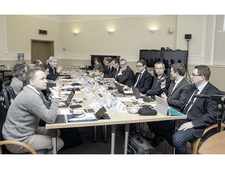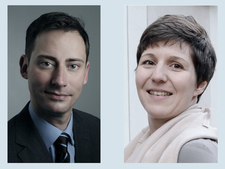-
Topics
subnavigation
Topics
Electromagnetic fields
- What are electromagnetic fields?
- Static and low-frequency fields
- Radiation protection relating to the expansion of the national grid
- High-frequency fields
- Radiation protection in mobile communication
Optical radiation
Ionising radiation
- What is ionising radiation?
- Radioactivity in the environment
- Applications in medicine
- Applications in daily life and in technology
- Effects
- What are the effects of radiation?
- Effects of selected radioactive materials
- Consequences of a radiation accident
- Cancer and leukaemia
- Genetic radiation effects
- Individual radiosensitivity
- Epidemiology of radiation-induced diseases
- Ionising radiation: positive effects?
- Risk estimation and assessment
- Radiation protection
- Nuclear accident management
- Service offers
-
The BfS
subnavigation
The BfS
- About us
- Science and research
- Laws and regulations
- BfS Topics in the Bundestag
- Links
International Commission reviews release of ruthenium-106
BfS-experts provide expertise
 First meeting of the Commission of Inquiry on Ruthenium in Moscow on 31 January 2018
Source: IBRAE
First meeting of the Commission of Inquiry on Ruthenium in Moscow on 31 January 2018
Source: IBRAE
Staff members of the Federal Office for Radiation Protection (Bundesamt für Strahlenschutz, BfS) support the Nuclear Safety Institute of the Russian Academy of Sciences (IBRAE) in the attempt to clarify increased ruthenium 106 concentrations, which were measured in large parts of Europe at the end of September 2017. An international commission of inquiry has been assigned to find out why this happened in the weeks and months to come. The Commission of Inquiry is made up of international experts from Germany, France, Finland, Sweden, Norway and Great Britain as well as Russian experts. The German experts come from BfS.
The first meeting of the Commission of Inquiry was held in Moscow on 31 January 2018. The findings of the international and Russian experts were presented and discussed in depth at the meet-ing. All countries presented their measurement data and calculations of the propagation of ruthenium-106 in the atmosphere and the possible causes of the release. Russia's supervisory authority (Rostechnadsor) reported on its inspections of Russian nuclear sites. On the basis of these findings, first joint conclusions were drawn. The most important points are:
- The total activity of ruthenium-106 in the air between late September and early October 2017 was about 100 terabecquerels (i. e. about 1 · 1014 becquerels).
- There was no health hazard to the population in all places where Ruthenium-106 was detected in the air.
- The Commission of Inquiry will collect and evaluate all available data on ruthenium-106, in-cluding local weather data at the measuring sites.
- The data currently available do not allow conclusions to be drawn on the location of the re-lease of ruthenium-106.
- The Commission of Inquiry considers further measurements to be necessary, starting from the locations where ruthenium-106 was detected in the Chelyabinsk region.
The Nuclear Safety Institute of the Russian Academy of Sciences (IBRAE) has published the full conclusions on its website. The Commission of Inquiry will inform the public about the results and conclusions of its work. At the Commission's inaugural meeting, the need for further meetings was recognised. The next meeting will be held in Moscow on 11 April 2018.
Background information

![]() Representation of the propagation of ruthenium-106 in the Chelyabinsk region during a potential release at the end of September 2017 (white: no measurement result, blue: very low concentration, green: low concentration)
Representation of the propagation of ruthenium-106 in the Chelyabinsk region during a potential release at the end of September 2017 (white: no measurement result, blue: very low concentration, green: low concentration)
At the end of September 2017, slightly increased radioactivity values in the air were detected at various trace points in Europe. Small quantities of ruthenium-106 were measured at a total of seven stations in Germany and at numerous stations in other European countries (including Austria and Italy). The concentration of the radioactive substance in Germany was very low between a few microbecquerels and a few millibecquerels per cubic meter.
BfS calculations on the propagation of radioactive substances in the atmosphere indicated an origin in the southern Urals, and a place of origin in southern Russia could not be ruled out initially. How-ever, data from the Russian meteorological service Roshydromet at the end of November 2017 suggest that areas west and south of the Urals can be excluded due the prevailing wind direction at that time.
Ruthenium-106 is a beta emitter, and its daughter nuclide Rhodium-106 is a very short-lived gamma emitter, so that beta and gamma rays always occur together during the decay of ruthenium-106. Ruthenium-106 has a half-life of slightly more than one year (372 days). Ruthenium-106 is a fission product occurring during the fission of uranium in a nuclear power plant.

![]() Measuring points at which ruthenium-106 was detected in the air between the end of September and the beginning of October 2017
Measuring points at which ruthenium-106 was detected in the air between the end of September and the beginning of October 2017
Ruthenium-106 is used, among others, as a radiation source for cancer therapy in the treatment of eye tumours. In addition, ruthenium-106 is rarely applied in Radioisotope Thermoelectric Generators (RTG), which are used to power satellites. Ruthenium can also occur in the reprocessing of nu-clear fuel assemblies.
State of 2018.02.16



